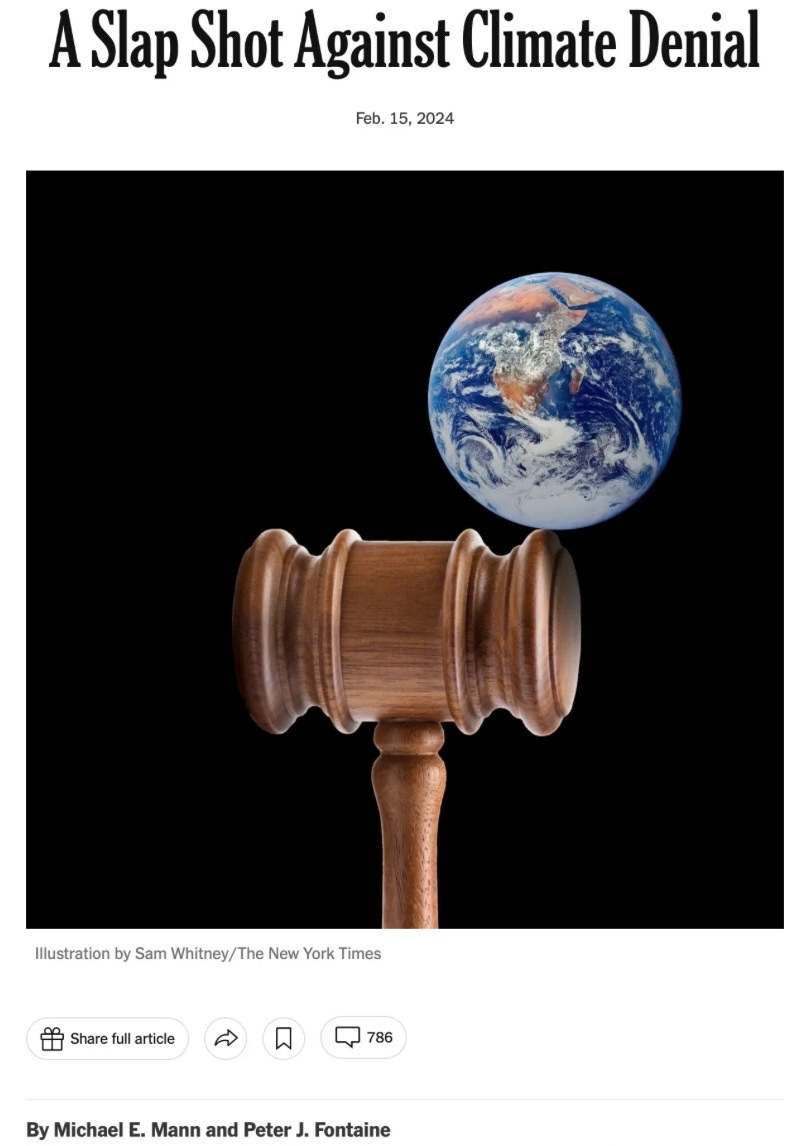5 Reasons Why I'm Canceling My Subscription To The New York Times
After 30+ years, I’m done. An 83% price increase? Forget it. Plus, four other reasons why I'm moving on.

We have lived in Austin for 40 years. And for nearly all of that time, Lorin and I have subscribed to the New York Times. For decades, we took the paper version. When that got too pricey, we switched to the digital-only subscription. Last week, we got a notice of a price increase. Instead of paying $18 monthly, the Times wants us to pay $33!
That’s the last straw.
I love newspapers and the smell of newsprint. I grew up with newspapers. My parents took the Tulsa World, delivered in the mornings, and the Tulsa Tribune came in the afternoon. I read them both religiously. Early in my career, I published articles in both. I’ve been a reporter for four decades. I’ve long considered the Times to be essential to my job. I’ve written for the Times. In the 1990s, I worked as a stringer for the paper and briefly (very briefly) had hopes of landing a job there. I’ve published op-eds in the Times, including one on the silliness of carbon capture and another on N2N, natural gas to nuclear.
But the Times has lost its credibility and its relevance. Its credo was once “all the news that’s fit to print.” That slogan is now almost a laugh line. The Times has devolved into an agenda-driven outlet that refuses to cover anything that doesn’t fit its agenda. Of course, the same could be said of many — or perhaps most — news outlets. The difference is that the Times has long been considered the paper of record. Given that, it should, in theory anyway, strive for evenhandedness. However, the paper no longer publishes anything close to what might be considered “fair,” particularly when it comes to reporting on energy and climate issues.
Here are five reasons why I’m canceling our subscription.
1. An 83% price increase is absurd
Yes, inflation is here. Prices are rising for everything from eggs to copper, and Tariff Man’s on-again, off-again gyrations are likely to mean higher prices on a whole lot of things. But for the Times to nearly double its price with no increase in access or quality? That’s insulting. And it’s particularly insulting given the myriad of other outlets available at lower cost or for free. (The Times trades under the ticker NYT. It has a market capitalization of about $8 billion and booked a $294 million profit last year.)
2. The paper still hasn’t published a full investigation into origins of the Covid pandemic
The most likely cause of the pandemic was a lab leak from the Wuhan Institute of Virology. But the Times, which prides itself on its investigative work, has never published a complete analysis of exactly what happened and why. To be clear, last year, the oped section ran a piece by Alina Chan on five reasons why the pandemic “probably started in a lab.” (In late 2021, Chan and Matt Ridley published Viral: The Search for the Origin of COVID-19. In 2023, Chan was on the Power Hungry Podcast.) In January, the Times ran a piece by Julian E. Barnes acknowledging that the CIA now favors the lab leak theory. (Barnes covers security and intelligence-related issues for the paper.)
Last month, again, on the opinion page, Zeynep Tufekci, a columnist at the paper, published a piece that served as a partial apology, titled “We Were Badly Misled About The Event That Changed Our Lives.”
Badly misled? There’s an understatement. But why is the Times only admitting this on the opinion pages? Where’s the investigation? Where’s the analysis of the US tax dollars spent supporting the work at Wuhan? Where’s the investigation into Anthony Fauci’s role in this scandal?
It appears the Times isn’t interested. Nicholas Wade was the science editor at the Times from 1990 to 1996, and from 1997 to 2012, he was a science reporter for the paper. On May 2, 2021, Wade published an 11,000-word piece on the origin of Covid, including a discussion of the possibility of a lab leak. The subhead explained his goal: “Did people or nature open Pandora’s box at Wuhan?” However, Wade didn’t publish that article in the Times. Instead, he published it in Medium. Here’s the key line in Wade’s article:
To my knowledge, no major newspaper or television network has yet provided readers with an in-depth news story of the lab escape scenario, such as the one you have just read, although some have run brief editorials or opinion pieces. One might think that any plausible origin of a virus that has killed three million people would merit a serious investigation. (Emphasis added.)
Yes, one might think precisely that. One might also believe the Times would be interested in publishing such a piece from one of the world’s top science reporters, particularly given that Wade spent two decades working there. That didn’t happen.
On May 17, 2021, another top science reporter, Donald G. McNeil Jr., who also worked at the Times for years, wrote a similar piece headlined: “How I Learned to Stop Worrying And Love the Lab-Leak Theory.” That, too, was published on Medium.
About 1.2 million Americans died from Covid. The global death toll could be as high as 21 million. On April 7, US Right To Know published a story based on documents obtained through the Freedom of Information Act. The documents show that the US Defense Intelligence Agency had determined as early as June 2020 that the genome of the virus that caused COVID-19 is “consistent with the hypothesis” that it was a “lab-engineered virus” that “escaped from containment.” Given the staggering death toll, economic costs, and the news that the DIA suspected a lab leak as early as June 2020, one might think, as Wade did in 2021, that the origin of the virus would “merit a serious investigation” by a newspaper of record.
Last Friday, I talked to a former Times reporter who succinctly summarized the situation. The Covid lab leak, he said, is “the biggest scandal in science history, and the Times has refused to investigate it, and it went along with the coverup.”
3. It hasn’t written a word about Michael Mann’s embarrassing losses in his defamation case against his critics
This lack of coverage is appalling. As I explained in these pages last month, University of Pennsylvania climate scientist Michael Mann attempted to intimidate his critics by suing them. That effort has backfired in spectacular fashion. But you wouldn’t know that by reading the Times.
Mann filed his defamation case in 2012. Much has happened since then, but here’s a short rundown of the latest developments. Last month, a federal court judge sanctioned Mann and his lawyers for their “extraordinary” misconduct during the proceedings. The judge said they “knowingly made a false statement of fact to the Court and Dr. Mann knowingly participated in the falsehood.” The judge will likely issue fines against Mann and his lawyers amounting to tens of thousands of dollars. Also in March, the same judge reduced the punitive damages awarded to Mann by a jury last year against one of the defendants from $1,000,000 to $5,000. And in February, the judge ruled that Mann must pay National Review’s legal fees totaling $530,820.21.
There’s more. On April 3, as reported by Roger Pielke Jr. on Twitter/X, Mann’s appeal of the ruling to pay those fees was denied. Thus, Mann, who has long been a darling of climate activists, is now on the hook for half a million dollars in legal fees because of his frivolous litigation.
A search of the Times’ archives shows it hasn’t reported on any of this. The last thing the Times published on Mann and his defamation case appeared on February 15, 2024, (see above) when it ran a self-serving op-ed by Mann and his lawyer, Peter J. Fontaine, called “A Slap Shot Against Climate Denial.” In that piece, the two claimed their lawsuit was “part of a larger culture war in which research is distorted and the truth about the climate threat is dissembled.”
Why hasn’t the Times retracted that op-ed? Why won’t it report on Mann’s humiliating losses and the court sanctions? Unfortunately, it appears the Times prefers to help Mann continue dissembling. Again, this is just appalling.
4. Its energy reporting is often laughably bad
Last May, in a piece titled “The H Stands For Hype,” I focused on a piece by Times reporters Stanley Reed and Melissa Eddy about a “green” hydrogen project in Germany. The piece was headlined, “Hydrogen Offers Germany a Chance to Take a Lead in Green Energy.” Reed and Eddy wrote:
The concept of hydrogen as a renewable energy source has been around for years, but only within the past decade has the idea of its potential to replace fossil fuels to power heavy industry taken off, leading to increased investment and advances in the technology. (Emphasis added.)
In my critique, I noted that hydrogen is not a “source” of energy; it is an energy carrier. Like gasoline or electricity, hydrogen has to be manufactured. The article, which focused on ThyssenKrupp’s plans to produce “green” steel, did not include any estimates of how much electricity would be required to make the hydrogen or mention the difficulties of handling hydrogen. Nor was there any analysis of the difficulties of expanding hydrogen production. Instead, the article was a prime example of gullible journalists accepting a too-good-to-be-true pitch about alt-energy.
What’s the status of the project that Reed and Eddy hyped less than a year ago? Last month, Thyssenkrupp announced it was suspending its green hydrogen project because “it is becoming clear that the offered prices will be significantly higher than assumed and that other framework parameters of the hydrogen economy, which is developing more slowly than expected, will change considerably.” A search of the Times shows it has not published anything about ThyssenKrupp’s suspension of the hydrogen project.
5. I’m all in on Substack
Substack is surging. This platform is fundamentally changing the way writers and other creators engage with audiences and how they get paid. Rather than paying the Times $33 per month, I will spend it on the Substack writers I trust and admire.
In closing, I will admit that I will probably miss the Times, but only a little.
Before you go:
Please click that ♡ button, subscribe, and share.
I have opened the comment section on this piece to free and paid subscribers alike.




Possibly the NYT should change its motto to “All the news that’s shit, we print”??
Substack has been a good development. The issue I'm running into is it's getting costly subscribing to individual writers. Many of us want to read widely. This starts adding up. I think it also runs the risk of putting us into silos since readers will tend to follow writers that affirm their beliefs and won't see other views that one sees when going through a newspaper/magazine (hardcopy or website). Traditional media certainly has controlled what we read - more so now than in the past. While it often falls short (as this piece by Robert illustrates) it still can help understand a wider range of information/views. I hope Substack evolves to address these and other issues. On that note, maybe The Bulwark provides a model to help with cost - a more affordable option to read more widely (and probably wider exposure for writers too).